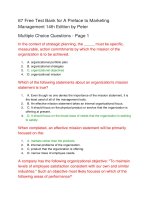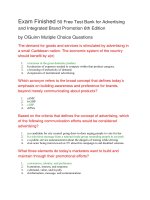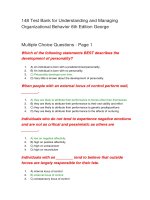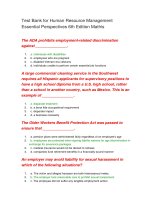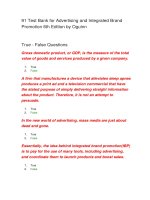Test bank for radiation protection in medical radiography 6th edition by sherer
Bạn đang xem bản rút gọn của tài liệu. Xem và tải ngay bản đầy đủ của tài liệu tại đây (48.27 KB, 6 trang )
buy this full document at
Sherer: Radiation Protection in Medical Radiography, 6th Edition
Chapter 01: Introduction to Radiation Protection
Test Bank
MULTIPLE CHOICE
1. Some consequences of ionization in human cells include:
1. creation of unstable atoms
2. production of free electrons
3. creation of reactive free radicals capable of producing substances poisonous to the
cell
A. 1 only
B. 2 only
C. 3 only
D. 1, 2, and 3
ANS: D
REF: 2
2. When natural sources of ionizing radiation become increased because of accidental or
deliberate human actions such as mining, they are referred to as _____ sources.
A. artificial
B. enhanced natural
C. extraterrestrial
D. manmade
ANS: B
REF: 14
3. Electromagnetic radiation can travel through space in the form of a wave but can interact
with matter as a particle of energy. This dual nature is referred to as:
A. wave attenuation capability
B. wave-particle interchange ability
C. wave-particle duality
D. wave-particle phenomena
ANS: C
REF: 9
4. Which of the following statements concerning the 1979 nuclear reactor accident at TMI-2
is not true?
A. Excess cancer deaths have been predicted to occur in the 2 million people living
within 50 miles of the plant at the time of the accident.
B. Excess cancer deaths have not been predicted to occur in the 2 million people
living within 50 miles of the plant at the time of the accident.
C. The equivalent dose (EqD) received by 2 million people living in the vicinity of
the nuclear reactor at the time of the accident was 0.02 mSv (2 mrem).
D. No melt-through of the reactor vessel occurred during the accident.
buy this full document at
Full file at />ANS: A
REF: 19
5. Which of the following is a special form of radiation that is capable of creating
electrically charged particles by removing orbital electrons from the atom of the material
with which it interacts?
A. Ionizing radiation
B. Nonionizing radiation
C. Subatomic radiation
D. Ultrasonic radiation
ANS: A
REF: 2
6. Patients who have an understanding of the medical benefits of an imaging procedure
because they received factual information about the study before having the examination
are more likely to:
A. assume a small risk of biologic damage but not overcome any radiation phobia
they may have
B. cancel their scheduled procedure because they are not willing to assume a small
risk of biologic damage
C. overcome any radiation phobia but not be willing to assume a small risk of
possible biologic damage
D. overcome any radiation phobia and be willing to assume a small risk of possible
biologic damage
ANS: D
REF: 8
7. Terrestrial radiation includes which of the following sources?
A. Long-lived radioactive elements, such as uranium-238, radium-226, and thorium232 that are present in variable quantities in the crust of the earth
B. Radioactive fallout from nuclear weapons tests in which detonation occurred above
ground
C. The sun and other stars
D. Video display terminals and television receivers
ANS: A
REF: 14
8. According to the U.S. Environmental Protection Agency (EPA), radon levels in homes
should not exceed what level?
A. 200 pCi/L
B. 135 pCi/L
C. 47 pCi/L
D. 4 pCi/L
ANS: D
REF: 17
9. Cosmic radiation occurs in which two forms?
A. Solar and manmade
B. Artificial and galactic
Copyright © 2011 by Mosby, Inc., an affiliate of Elsevier Inc.
Full file at />C. Natural background and artificial
D. Solar and galactic
ANS: D
REF: 17
10. The U.S. Food and Drug Administration (FDA) presently considers the risk of radiation
exposure to the U.S. population from color television monitors to be:
A. substantial
B. moderate
C. very slight
D. negligible
ANS: D
REF: 18
11. Through which of the following routes can radon enter houses?
1. Crawl spaces under living areas
2. Floor drains and sump pumps
3. Porous cement block foundations
A. 1 and 2 only
B. 1 and 3 only
C. 2 and 3 only
D. 1, 2, and 3
ANS: D
REF: 15
12. Acute melting of the uranium dioxide fuel of a nuclear reactor core requires how great a
temperature?
A. Less than 500° F
B. At least 1000° F
C. 2000° F
D. Greater than 5000° F
ANS: D
REF: 19
13. When exposed to high radon levels in the home, which of the following groups of people
have the highest risk of developing lung cancer?
A. Infants
B. Toddlers
C. Nonsmokers
D. Smokers
ANS: D
REF: 17
14. As of 1987, of the estimated 0.65 mSv (65 rem) that manmade radiation contributed to
the average annual radiation exposure of the U.S. population, what portion of this
resulted from the use of consumer products?
A. 0.01 mSv (1 mrem)
B. 0.11 mSv (11 mrem)
Copyright © 2011 by Mosby, Inc., an affiliate of Elsevier Inc.
Full file at />C. 0.21 mSv (21 mrem)
D. 0.31 mSv (31 mrem)
ANS: B
REF: 18
15. Which of the following helps shield the global population from exposure to essentially
all high-energy, bombarding cosmic rays?
A. Clouds
B. Fog
C. Earth’s atmosphere and magnetic field
D. Smog
ANS: C
REF: 17
16. Which of the following is considered by the EPA to be the second leading cause of lung
cancer in the United States?
A. Annual posteroanterior and lateral chest radiographs
B. Cosmic ray exposure
C. Radon exposure
D. Fluoroscopic examination of the upper gastrointestinal tract
ANS: C
REF: 17
17. Which of the following are forms of electromagnetic radiation?
1. Microwaves
2. Visible light
3. X-rays
A. 1 and 2 only
B. 1 and 3 only
C. 2 and 3 only
D. 1, 2, and 3
ANS: D
REF: 9
18. The amount of energy transferred to electrons by ionizing radiation is the basis of the
concept of:
A. electromagnetic radiation
B. nuclear power
C. radioactive decay
D. radiation dose
ANS: D
REF: 11
19. In the electromagnetic spectrum, higher frequencies are associated with _____
wavelengths and _____ energies.
A. longer; lower
B. longer; higher
C. shorter; lower
D. shorter; higher
Copyright © 2011 by Mosby, Inc., an affiliate of Elsevier Inc.
Full file at />ANS: D
REF: 11
20. Both occupational and nonoccupational dose limits may be stated in units of:
1. Coulomb per kilogram (roentgen)
2. Gray (rads)
3. Sievert (rem)
A. 1 only
B. 2 only
C. 3 only
D. 1, 2, and 3
ANS: C
REF: 13
21. A flight on a typical commercial airliner results in an equivalent dose rate of _____
mSv/hr (_____ mrem/hr).
A. 0.001 to 0.005; 0.1 to 0.5
B. 0.005 to 0.01; 0.5 to 1
C. 0.02 to 0.04; 2 to 4
D. 0.05 to 0.09; 5 to 9
ANS: B
REF: 18
22. The first decay product of radium is:
A. cesium
B. radon
C. strontium
D. x-ray
ANS: B
REF: 15
23. The millisievert (mSv) is equal to _____ of 1 sievert.
A. 1/10
B. 1/100
C. 1/1000
D. 1/10,000
ANS: C
REF: 9
24. The advantages of the BERT method are:
1. it does not imply radiation risk; it is simply a means for comparison
2. it emphasizes that radiation is an innate part of our environment
3. the answer given in terms of BERT is easy for the patient to comprehend
A. 1 and 2 only
B. 1 and 3 only
C. 2 and 3 only
D. 1, 2, and 3
ANS: D
REF: 9
Copyright © 2011 by Mosby, Inc., an affiliate of Elsevier Inc.
Full file at />25. If a patient asks a radiographer a question about the potential risk of radiation exposure
associated with a specific x-ray procedure, the radiographer should:
A. use his or her intelligence and knowledge to answer the question honestly and
provide a suitable example that compares the amount of radiation received from
the procedure in question with natural background radiation received over a given
period of time
B. avoid the patient’s question by changing the subject
C. tell the patient that it is unethical to discuss such concerns
D. refuse to answer the question and recommend that he or she speak with the
referring physician
ANS: A
REF: 9
Copyright © 2011 by Mosby, Inc., an affiliate of Elsevier Inc.
